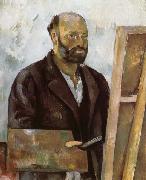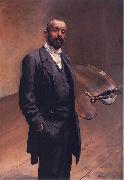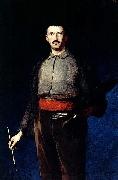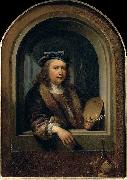
|
Paul Cezanne
|
|||
|
|
|||
| French Post-Impressionist Painter, 1839-1906 During the second half of the 19th century French impressionism created a dramatic break with the art of the past. In conception and appearance the style was radically new and, although it initially inspired public ridicule, it soon affected nearly every ambitious artist in western Europe. The new vision emerged during the 1870s, chiefly in the art of Claude Monet, Auguste Renoir, and Camille Pissarro. For each of these artists impressionism was an illusionistic style which differed from the tradition of Renaissance illusionism in its greater emphasis upon vibrant, natural color and on an immediate confrontation with the phenomena of the visible world. As the style developed during the 1880s, however, it increasingly became characterized by paintings which were flat rather than illusionistic. In other words, the impressionists insistence upon a direct application of pigment to canvas resulted in surfaces which declared themselves first of all as surfaces - and, consequently, in paintings which declared themselves first of all as paintings rather than as windows which looked out upon the natural world. The tendency toward flatness persisted into the last years of the 19th century, its pervasiveness giving the impression that illusionistic space - fought for, won, and defended since the very beginning of the Renaissance - had finally been sacrificed by the medium of painting. Paul C??zanne worked within and finally emerged from this trend. As a painter, he matured slowly, his greatest works coming during the last 25 years of his life. During this period he scored a remarkable and heroic achievement: he restored to painting the space and volume that had seemingly been lost to it. But he did it in a totally unprecedented way: not by return to the illusionism of the past but by the creation of a spatial illusionism that did not violate flatness. C??zanne was born on Jan. 19, 1839, in Aix-en-Provence. His father, Philippe Auguste, was the cofounder of a banking firm which prospered throughout the artist life, affording him financial security that was unavailable to most of his contemporaries and eventually resulting in a large inheritance. In 1852 C??zanne entered the Coll??ge Bourbon, where he met and became friends with Émile Zola. This friendship was decisive for both men: with youthful romanticism they envisioned successful careers in the Paris art world, C??zanne as a painter and Zola as a writer. Consequently, C??zanne began to study painting and drawing at the École des Beaux-Arts in Aix in 1856. His father opposed the pursuit of an artistic career, and in 1858 he persuaded C??zanne to enter law school at the University of Aix. Although C??zanne continued his law studies for several years, he was simultaneously enrolled in the School of Design in Aix, where he remained until 1861. In 1861 C??zanne finally convinced his father to allow him to go to Paris. He planned to join Zola there and to enroll in the École des Beaux-Arts. But his application was rejected and, although he had gained inspiration from visits to the Louvre, particularly from the study of Diego Vel??zquez and Caravaggio, C??zanne experienced self-doubt and returned to Aix within the year. He entered his father banking house but continued to study at the School of Design. The remainder of the decade was a period of flux and uncertainty for C??zanne. His attempt to work in his father business was abortive, and he returned to Paris in 1862 and stayed for a year and a half. During this period he met Monet and Pissarro and became acquainted with the revolutionary work of Gustave Courbet and Édouard Manet. C??zanne also admired the fiery romanticism of Eug??ne Delacroix paintings. But he was never entirely comfortable with Parisian life and periodically returned to Aix, where he could work in relative isolation. He retreated there, for instance, during the Franco-Prussian War (1870-1871). | |||
|
|
|||
|
Self-Portrait with a Palette new3/Paul Cezanne-772742.jpg Painting ID:: 27760 |
mk62 1885-1887 Oil on canvas 92x73cm Zurich,Stiftung Sammlung E.G.Buhrle | ||
|
|
|||
|
Jacek Malczewski
|
|||
|
|
|||
| (15 July 1854 in Radom - 8 October 1929 in Krakow) was one of the most famous painters of Polish Symbolism. In his creativity he successfully joins the predominant style of his times with motifs of Polish martyrdom. | |||
|
|
|||
|
Self-portrait with a palette new24/Jacek Malczewski-376478.jpg Painting ID:: 76499 |
1892(1892) Oil on canvas 160.5 ?? 110 cm (63.2 ?? 43.3 in) cjr | ||
|
|
|||
|
Jacek Malczewski
|
|||
|
|
|||
| (15 July 1854 in Radom - 8 October 1929 in Krakow) was one of the most famous painters of Polish Symbolism. In his creativity he successfully joins the predominant style of his times with motifs of Polish martyrdom. | |||
|
|
|||
|
Self-portrait with a palette new24/Jacek Malczewski-735648.jpg Painting ID:: 78303 |
1892(1892) Medium Oil on canvas Dimensions 160.5 x 110 cm (63.2 x 43.3 in) cyf | ||
|
|
|||
|
Ludwik de Laveaux
|
|||
|
|
|||
| painted Parisian Opera at night. in 1892 - 1893 | |||
|
|
|||
|
Self-portrait with a palette new25/Ludwik de Laveaux-793795.jpg Painting ID:: 88697 |
1892(1892) Medium Oil on canvas Dimensions 115 x 172 cm (45.3 x 67.7 in) cyf | ||
|
|
|||
|
Gerard Dou
|
|||
|
|
|||
| Leiden 1613-1675 was a Dutch Golden Age painter, whose small, highly-polished paintings are typical of the Leiden fijnschilders. He specialised in genre scenes and is noted for his trompe l'oeil "niche" paintings and candlelit night-scenes with strong chiaroscuro. His first instructor in drawing and design was Bartholomew Dolendo, an engraver; and he afterwards learned the art of glass-painting under Peter Kouwhoorn. At the age of 15 he became a pupil of Rembrandt, with whom he continued for three years. From the great master of the Dutch school he acquired his skill in coloring, and in the more subtle effects of chiaroscuro; and the style of Rembrandt is reflected in several of his earlier pictures, notably in a portrait of himself at the age of 22, in the Bridge-water House gallery, and in the "Blind Tobit going to meet his Son", at Wardour Castle. At a comparatively early point in his career, however, he had formed a manner of his own distinct from, and indeed in some respects antagonistic to, that of his master. Gifted with unusual clearness of vision and precision of manipulation, he cultivated a minute and elaborate style of treatment; and probably few painters ever spent more time and pains on all the details of their pictures down to the most trivial. He is said to have spent five days in painting a hand; and his work was so fine that he found it necessary to manufacture his own brushes. Notwithstanding the minuteness of his touch, however, the general effect was harmonious and free from stiffness, and his color was always admirably fresh and transparent. He was fond of representing subjects in lantern or candle light, the effects of which he reproduced with a fidelity and skill which no other master has equaled. He frequently painted by the aid of a concave mirror, and to obtain exactness looked at his subject through a frame crossed with squares of silk thread. His practice as a portrait painter, which was at first considerable, gradually declined, sitters being unwilling to give him the time that he deemed necessary. His pictures were always small in size, and represented chiefly subjects in still life. Upwards of 200 are attributed to him, and specimens are to be found in most of the great public collections of Europe. His chef-d'oeuvre is generally considered to be The dropsical woman, 1663, and The Dutch Housewife, 1650, both in the Louvre. The Evening School, in the Amsterdam Rijksmuseum, is the best example of the candlelight scenes in which he excelled. In the National Gallery, London, favorable specimens are to be seen in the Poulterer's Shop, | |||
|
|
|||
|
self-portrait with a Palette new25/Gerard Dou-559468.jpg Painting ID:: 89115 |
between 1660(1660) and 1665(1665) Medium oil on wood cyf | ||
|
|
|||
|
Also Buy::. For Following Paintings / Artists / Products, Please Use Our Search Online: |












